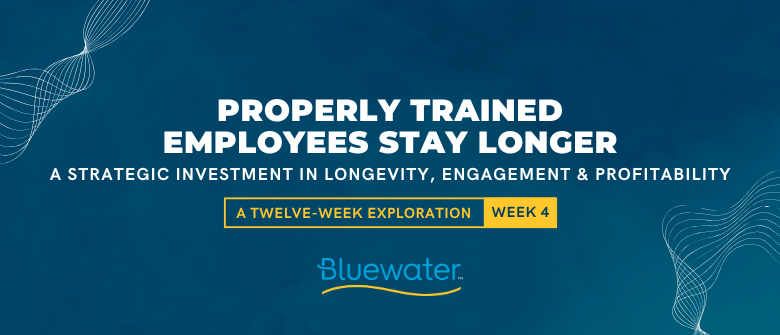Investing in Employee Development Improves Longevity, Engagement, and Profitability
by Chris Bond | October 17, 2024 11:15 AM |

Employee retention remains a top challenge for organizations in today’s competitive job market. With talented professionals having numerous career options, companies must go beyond compensation to retain employees. One of the most effective ways to achieve long-term retention is through continuous employee training and development. Properly trained employees not only perform better but are also more likely to stay with the company, significantly reducing the financial and operational burden of turnover.
Understanding the Full Cost of Employee Turnover
While the direct cost of recruiting and onboarding a new employee is substantial, the total impact of turnover extends well beyond recruitment expenses. According to the Society for Human Resource Management (SHRM), the average cost to hire a new employee is approximately $4,700. However, LinkedIn's more comprehensive analysis suggests that organizations should budget between 50% and 250% of an employee’s annual salary and benefits to cover the total replacement cost.
Based on this model, the cost to replace a $75,000-per-year employee could range:
- $37,500 (for entry-level employees)
- $187,500 (for managers, leaders, or specialized roles)
These costs include not only recruitment and onboarding but also:
- Lost productivity: New hires take time to become fully effective in their roles.
- Onboarding and training: Teams and managers must dedicate resources to training new hires.
- Disrupted operations and team dynamics: Replacing experienced employees often destabilizes teams and processes.
- Loss of institutional knowledge and customer relationships: Departing employees take valuable knowledge with them, which can erode business continuity.
The financial burden becomes even more significant when organizations experience frequent turnover, resulting in lost time, declining morale, and diminished productivity.
How Learning Technology Drives Retention and Engagement
Investing in continuous learning is one of the most effective ways to reduce turnover. Learning technology provides employees with opportunities to develop new skills, stay engaged, and align their growth with the organization’s strategic objectives. When employees feel their employer is committed to their development, they are more likely to stay loyal and engaged.
Modern learning platforms offer the following benefits:
- Adaptive, role-based learning paths: Customized content aligned with individual goals and company priorities.
- Self-paced learning modules: Employees can learn at their own pace without disrupting their workflow.
- Gamification and certifications: Incentives, such as badges and certificates, boost engagement.
- Microlearning: Short, focused lessons help employees stay current with new skills.
These development strategies create an environment where employees feel valued and empowered, which leads to increased job satisfaction and loyalty.
The Financial and Operational Benefits of Retaining Talent
Reducing turnover is not just about avoiding replacement costs—it’s also about building long-term organizational strength. Employees who stay with a company longer develop deeper expertise, strengthen client relationships, and improve team performance. Experienced employees also mentor newer staff, fostering knowledge transfer and team cohesion.
Organizations with high retention rates enjoy:
- Increased productivity: Stable teams work more efficiently and effectively.
- Stronger morale: Employees feel valued and motivated to contribute.
- Improved customer satisfaction: Long-term employees build stronger customer relationships.
- Operational resilience: Retaining talent ensures continuity and minimizes disruptions during transitions.
A Data-Driven Approach to Measuring the Financial Impact of Learning
Later this year, Bluewater will publish a model for measuring the financial impact of learning, helping organizations quantify how investing in employee development translates to real business outcomes. This framework will provide insights into the return on investment (ROI) of learning initiatives, demonstrating how continuous training leads to reduced turnover, enhanced productivity, and increased profitability.
By leveraging this model, organizations can better evaluate the cost-benefit of their learning programs and align these investments with strategic business objectives. This approach will help businesses optimize their training budgets while maximizing the impact on employee retention and performance.
Investing in Learning for Long-Term Success and Profitability
In today’s dynamic market, investing in employee development is essential for building a resilient workforce. Continuous learning not only enhances skills and productivity but also creates a culture of growth and loyalty. By aligning personal development with business goals, organizations can reduce turnover, preserve institutional knowledge, and foster long-term success.
With Bluewater’s upcoming financial impact model, companies will gain the tools necessary to measure the full value of learning initiatives. Organizations that prioritize learning will not only retain top talent but also strengthen their competitiveness, ensuring sustainable growth and profitability in the years to come.
Search Our Blogs
Categories
- Ad Hoc (1)
- ADMIN (1)
- administration (1)
- AI (2)
- analytics (2)
- anxiety (1)
- Artificial intelligence (2)
- automation (1)
- BI (1)
- blog (1)
- Blueprint (1)
- center of excellence (10)
- Communication (2)
- COVID-19 (2)
- Culture (1)
- Custom Content (1)
- customer service (1)
- Data (1)
- Employee Engagement (1)
- Shark Bites - Cornerstone Edition (12)
- Shark Bites - SumTotal Edition (4)
- Shark Bites - Ultimate Edition (5)
- The Future of Learning (16)
- The Future of Talent Management (30)
- User Experience (2)
- UX (2)
- wellbeing (1)


